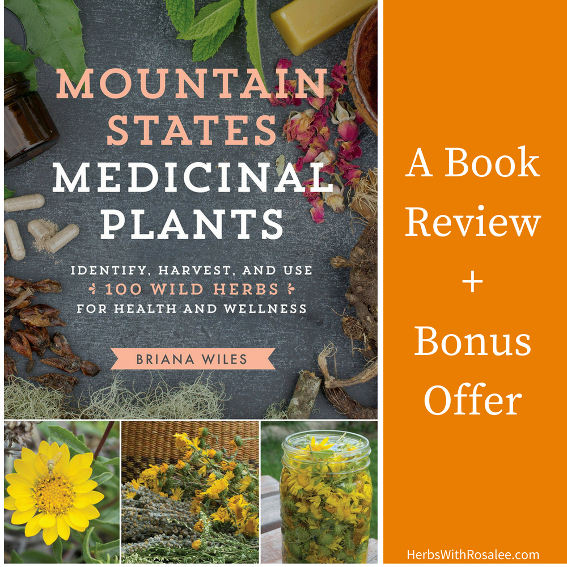Get weekly tips, recipes, and my Herbal Jumpstart e-course! Sign up for free today.

Mountain States Medicinal Plants
A book review by Kate Gienapp
Share this! |
|
Briana Wiles spends her time among stinging nettle, sagebrush, sumac, sweet clover and Starry Solomon’s Seal. To some, it might sound like unpleasant company; but for Wiles, the world of plants serves as a way to wellness. Wiles’ most recent guide Mountain States Medical Plants illustrates how to identify, use and harvest 100 wild herbs for health and wellness.
Wiles has written not one, but two foraging books, the other one being titled Mountain States Foraging: 115 Wild and Flavorful Edibles from Alpine Sorrel to Wild Hops. Her knowledge of wild medicine making comes from many sources: field guides, herbalism conferences, botanical teachers and, of course, being outdoors.
As the owner of Rooted Apothecary in Crested Butte, she offers her own line of body care products, remedies and potions made with foraged botanicals. She also teaches foraging and medicinal plant classes.
Most of the identification guides written for plants stick to the basic structure. Within the confines of a specific region the author classifies, describes and depicts a particular plant with a scientific structure and that’s the end of it.
The best part about Mountain States Medical Plants is that it offers something to everyone. If you are a transplant to the Rocky Mountains and it’s your very first hike in the woods, this guide will act as a friendly companion along the beaten path to learn native plants and their possible uses. If you are an expert in identifying plants in the mountain states, this book can deepen your understanding beyond simply identification to utilization. If you are a fan of foraging, want a recipe for dandelion tea, or have an interest in tinctures this book is for you.
Mountain State Medicinal Plants dives headlong into the abundance of healing herbs that grow right in our backyard, or meadow, or mountaintop. With 100 wild herb descriptions, this book acts as a guide for finding, identifying, harvesting and using wild medicinal plants of the western Rocky Mountain region.
Wiles offers clear and stunning photographs to accompany each wild herb for easy identification and concise description of the plant. Each herb also includes where, when and how to wildcraft, medicinal uses, cautions for certain herbs, and herbal preparations such as tinctures, teas and oils. The herbs are listed in alphabetical order for convenience with contents and index for fast-tracking your search on the trail.
Wiles provides detailed descriptions of the variety of ways that plants can be harvested, ranging from winnowing, dehydrating, drying, infusions, decoctions, sitz baths, extractions, oil infusions and salves.
The introduction outlines the timing of harvest, which can take place in spring, summer, autumn and even winter. For example, certain early spring plants can be found in open meadows or forest edges, whereas others can be found in wetlands or among sagebrush.
This guide establishes a set of guidelines for foraging that outlines the ways to wildcraft, beginning with the empowerment that comes from gathering information and inspiration from nature. Wiles works to establish a deeper connection to nature by opening your eyes to each exchange that takes place in nature, particularly with plants.
For Wiles, “every time you touch a plant it has a response, and so do you, if you take the time to notice it.” To go back to foraging is to revisit an old history that has existed as long as humans have existed, she points out. It’s a pleasant surprise to read a foraging book that considers our surroundings on both a physical and spiritual level.
This guide details the areas you might want to stay away from, such as railways, roads, and buildings. Wiles also takes into account the various public land agencies such as the Bureau of Land Management (BLM) or Fish and Wildlife, and others that all have different rules and regulations for harvesting.
On the other hand, Wiles explains the importance of “tending nature's garden” and to tend it with love, respect and care. She puts importance on leaving without a trace and taking the time to simply give thanks to our surroundings—the pollinators and the plants for everything they provide.
Mountain State Medicinal Plants effortlessly plays many roles. It can act as a guide for foraging in the wild, a constant kitchen companion, a collection of scenic photographs to peruse, or simply a friendly reminder to say hello to the plants and keep our connection to nature strong.
About the reviewer: Kate Gienapp is a staff writer at the Gunnison Country Times. She was born and raised in Gunnison, Colorado, and after earning her writing degree from Fort Lewis College in Durango, Colorado found herself right back at home in the Gunnison Valley where she loves to play outside.
